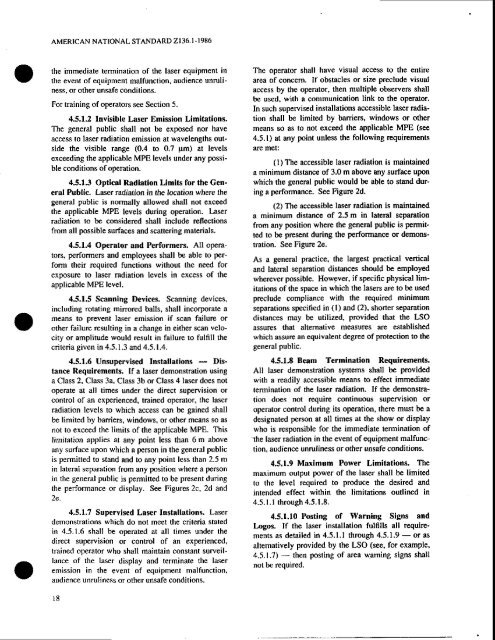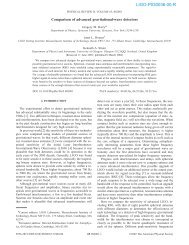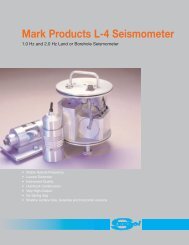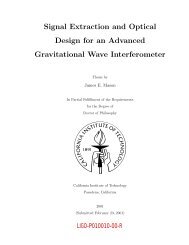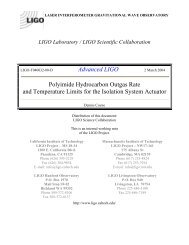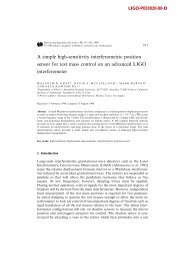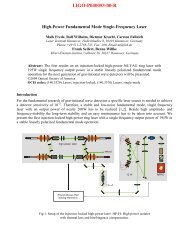for the sqfe use of lqsers - LIGO
for the sqfe use of lqsers - LIGO
for the sqfe use of lqsers - LIGO
You also want an ePaper? Increase the reach of your titles
YUMPU automatically turns print PDFs into web optimized ePapers that Google loves.
AMERICAN NATIONAL STANDARD 2I36.I-I986<br />
<strong>the</strong> immediate termination <strong>of</strong> <strong>the</strong> laser equipment in<br />
<strong>the</strong> event <strong>of</strong> equipment malfunction, audience unruliness,<br />
or o<strong>the</strong>r unsafe conditions.<br />
For training <strong>of</strong> operators see Section 5.<br />
4.5.1.2 Invisible Laser Emission Limitations.<br />
The general public shall not be exposed nor have<br />
access to laser radiation emission at wavelengths outside<br />
<strong>the</strong> visible range (0.4 to 0.7 pm) at levels<br />
exceeding <strong>the</strong> applicable MPE levels under any possible<br />
conditions <strong>of</strong> operation.<br />
4,5.1.3 Optical Radlatlon Limlts <strong>for</strong> <strong>the</strong> General<br />
Public. Laser radiation in <strong>the</strong> location where <strong>the</strong><br />
general public is normally allowed shall not exceed<br />
<strong>the</strong> applicable MPE levels during operation. hser<br />
radiation to be considered shall include reflections<br />
from all possible surfaces and scattering materials.<br />
4.5.1.4 Operator and Per<strong>for</strong>mers. Alt operators,<br />
per<strong>for</strong>mers and employees shall be able lo per<strong>for</strong>m<br />
<strong>the</strong>ir required functions without <strong>the</strong> need <strong>for</strong><br />
exposure to laser radiation levels in excess <strong>of</strong> <strong>the</strong><br />
applicable MPE level.<br />
4,5.1.5 Scanning Devices. Scanning devices,<br />
including rotating minored balls, shall incorporate a<br />
means to prevent laser emission if scan failure or<br />
o<strong>the</strong>r failure resulting in a change in ei<strong>the</strong>r scan velocity<br />
or amplitude would result in failure to fulfill <strong>the</strong><br />
criteria given in 4.5.1.3 and 4.5.1.4.<br />
4.5.1.6 Unsupervised Installaaions - Distanc€<br />
R€quirements. If a laser demonstration using<br />
a Class 2. Class 3a, Class 3b or Class 4 laser does not<br />
operate at all limes under <strong>the</strong> direct supervision or<br />
conhol <strong>of</strong> an experienced, trained operator, <strong>the</strong> laser<br />
radiation levels to which access can be gained shall<br />
be limited by baniers, windows, or o<strong>the</strong>r means so as<br />
not to exceed <strong>the</strong> limits <strong>of</strong> <strong>the</strong> applicable MPE. This<br />
limitation applies at any point less than 6 m above<br />
any surface upon which a penon in <strong>the</strong> general public<br />
is permitted to stand and to any point less than 2.5 m<br />
in lateral separation from any position where a person<br />
in <strong>the</strong> general public is permitted to be present du ng<br />
<strong>the</strong> per<strong>for</strong>mance or display. See Figures 2c, 2d and<br />
2e.<br />
4.5.1.7 Supervis€d Laser Installations. Laser<br />
demonstrations which do not meet <strong>the</strong> criteria stated<br />
in 4.5.1.6 shall be operated at all times under <strong>the</strong><br />
direct supervision or conrol <strong>of</strong> an experienced,<br />
trained operator who shall maintain constant surveillance<br />
<strong>of</strong> <strong>the</strong> laser display and terminate <strong>the</strong> laser<br />
emission in <strong>the</strong> event <strong>of</strong> equipment malfunction.<br />
audience unruliness or o<strong>the</strong>r unsafe conditions.<br />
18<br />
The operator shall have visual access to <strong>the</strong> entire<br />
area <strong>of</strong> concem. lf obstacles or size preclude visual<br />
access by <strong>the</strong> operator, <strong>the</strong>n multiple obsewers shall<br />
be <strong>use</strong>d, with a communication link to <strong>the</strong> operator,<br />
In such supervised installations accessible laser radiation<br />
shall be limited by baniers, windows or o<strong>the</strong>r<br />
means so as to not exceed <strong>the</strong> applicable MPE (see<br />
4.5.1) at any point unless <strong>the</strong> following requirements<br />
arc mer:<br />
(l ) The accessible laser radiation is maintained<br />
a minimum distance <strong>of</strong> 3.0 m above any sudace upon<br />
which <strong>the</strong> general public would be able to stand during<br />
a per<strong>for</strong>mance. See Figure 2d.<br />
(2) The accessible laser radiation is maintained<br />
a minimum distance <strong>of</strong> 2.5 m in lateral separation<br />
from any position where <strong>the</strong> general public is permitted<br />
to be prcsent during <strong>the</strong> per<strong>for</strong>mance or demonstration.<br />
See Figure 2e.<br />
As a general practice, <strong>the</strong> largest practical venical<br />
and lateral separation distances should be employed<br />
wherever possible. However, if specific physical limitations<br />
<strong>of</strong> <strong>the</strong> space in which <strong>the</strong> lasers are to be <strong>use</strong>d<br />
preclude compliance with <strong>the</strong> required minimum<br />
separations specified in (l) and (2), shorter separation<br />
distances may be utilized, provided that <strong>the</strong> LSO<br />
assures that altemative measurBs are established<br />
which assure an equivalent degree <strong>of</strong> protection to <strong>the</strong><br />
general public.<br />
4.5.1.8Beam Termination Requirements.<br />
All laser demonshation syslems shall be provided<br />
with a rcadily accessible means to effect immediate<br />
termination <strong>of</strong> <strong>the</strong> laser radiation. lf <strong>the</strong> demonstration<br />
does not require continuous supervision or<br />
operator control during its operation, <strong>the</strong>re must be a<br />
designated person at all times at <strong>the</strong> show or display<br />
who is responsible <strong>for</strong> <strong>the</strong> immediate termination <strong>of</strong><br />
<strong>the</strong> laser radiation in <strong>the</strong> event <strong>of</strong> equipment malfunction,<br />
audience unruliness or o<strong>the</strong>r unsafe cond.itions.<br />
45,1.9 Maximum Power Limitations. The<br />
maximum output power <strong>of</strong> <strong>the</strong> laser shall be limited<br />
to <strong>the</strong> level required to pmduce <strong>the</strong> desired and<br />
intended effect within <strong>the</strong> limitations outlined in<br />
4.5.1.1 through 4.5.1.8.<br />
4.5.1,10 Posting <strong>of</strong> Warning Signs and<br />
l-ogm. If <strong>the</strong> laser installation fulfills all requirements<br />
as detailed in 4.5.1.1 through 4.5.1.9 - or as<br />
altematively provided by <strong>the</strong> LSO (see, <strong>for</strong> example,<br />
4.5.1.7\ - <strong>the</strong>n posting <strong>of</strong> area waming signs shall<br />
not be required.


